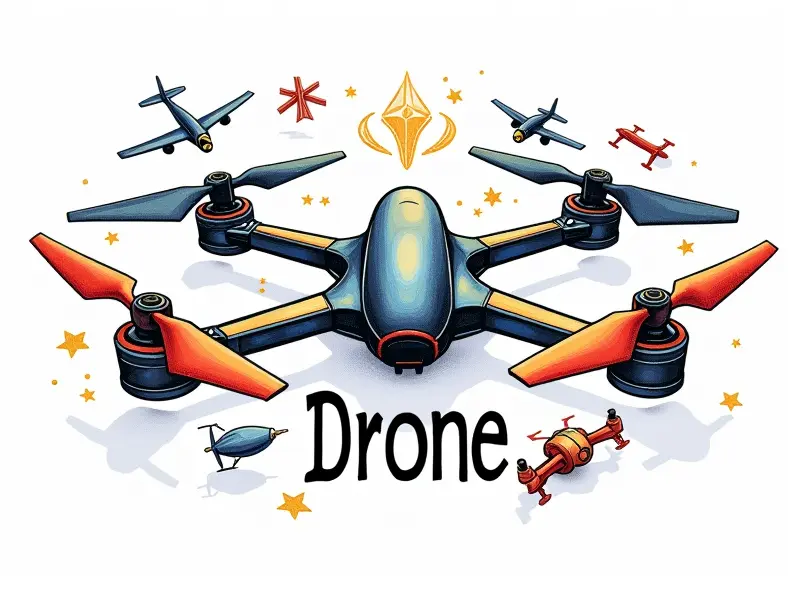What's a quadcopter?

Why Quadcopters Are So Popular
Quadcopters, also known as quadrotors or multirotor drones, have gained immense popularity in recent years due to their versatility and ease of use. These unmanned aerial vehicles (UAVs) are favored by hobbyists, professionals, and enthusiasts alike for a variety of applications ranging from aerial photography and videography to surveying and inspection tasks.
One major reason for the surge in quadcopter popularity is their compact size and maneuverability. Unlike traditional helicopters or fixed-wing aircraft, quadcopters can take off vertically and hover in place with ease. This makes them ideal for navigating tight spaces and capturing dynamic aerial footage that would be difficult or impossible to achieve with other types of drones.
Another factor contributing to their widespread appeal is the rapid advancement in technology. Modern quadcopters are equipped with sophisticated flight control systems, GPS navigation, and high-resolution cameras, making them more accessible and user-friendly than ever before. This has lowered the barrier to entry for hobbyists and professionals alike, allowing a broader range of users to enjoy the benefits of aerial drone technology.
What is a Quadcopter Explained
A quadcopter is an unmanned aerial vehicle (UAV) that features four rotors arranged in a square configuration. Each rotor is powered by its own electric motor, enabling precise control over lift and movement. The term "quadcopter" derives from the Latin word "quadrus," meaning "four," reflecting the aircraft's distinctive design.
The basic structure of a quadcopter consists of four arms extending outward from a central frame, with each arm housing one motor and propeller assembly. Two rotors spin clockwise (CW), while the other two rotate counterclockwise (CCW). This configuration allows for balanced lift and stability during flight.
Quadcopters differ significantly from traditional helicopters in their design and operation. While both types of aircraft use rotary wings to generate lift, quadcopters rely on a simpler mechanical setup that eliminates the need for complex mechanisms such as swashplates or tail rotors found in conventional helicopters. This simplicity translates into easier maintenance and lower operational costs.
Beginner's Guide to Quadcopters
If you're new to quadcopter flying, it's essential to start with the basics before diving into more advanced techniques. Here are some key points for beginners:
- Selecting a Suitable Model: Choose a beginner-friendly model that offers good stability and ease of control.
- Familiarizing Yourself with Controls: Learn how to operate the remote controller, including pitch, roll, yaw, and throttle functions.
- Understanding Flight Dynamics: Study basic principles such as lift generation, thrust-to-weight ratio, and aerodynamics.
- Safety Precautions: Always fly in open areas away from people and obstacles. Follow local regulations regarding drone usage.
How Do Quadcopters Work?
The operation of a quadcopter involves several key components working together to achieve stable flight:
- Motors and Propellers: Each motor drives a propeller, generating lift through the rotation.
- Inertial Measurement Unit (IMU): This sensor measures acceleration and angular velocity to maintain stability.
- Global Positioning System (GPS): Provides location data for navigation and positioning.
- Flight Controller: Manages all flight parameters, including altitude control and stabilization.
Quadcopter vs Helicopter: Differences
While both quadcopters and helicopters are rotary-wing aircraft, they differ in several critical aspects:
- Mechanical Complexity: Quadcopters have a simpler design with fewer moving parts compared to traditional helicopters.
- Flying Characteristics: Quadcopters offer better maneuverability and vertical takeoff/landing capabilities, whereas helicopters excel in sustained forward flight.
- Maintenance Requirements: Due to their simpler construction, quadcopters generally require less maintenance than traditional helicopters.
Top Uses for Quadcopters Today
The versatility of quadcopters makes them suitable for a wide range of applications:
- Aerial Photography and Videography: Capturing stunning aerial shots is one of the most popular uses.
- Surveying and Mapping: Quadcopters are used in agriculture, construction, and environmental monitoring for detailed surveys.
- Search and Rescue Operations: Their agility allows them to reach remote or hard-to-reach areas quickly.
Essential Features of Quadcopters
To ensure optimal performance, look for the following features when selecting a quadcopter:
- Built-in GPS: For precise navigation and positioning.
- Return to Home (RTH) Functionality: Automatically returns the drone to its takeoff point if signal is lost or battery runs low.
- Obstacle Avoidance Sensors: Helps prevent collisions with objects during flight.
Getting Started with Quadcopters
To begin your quadcopter journey, follow these steps:
- Choose the Right Model: Start with a beginner-friendly model that offers good stability and ease of control.
- Learn Basic Flight Controls: Familiarize yourself with pitch, roll, yaw, and throttle functions on your remote controller.
- Practice in Safe Environments: Begin flying in open areas away from people and obstacles to build confidence.
Quadcopter 101: The Ultimate Guide
This comprehensive guide covers everything you need to know about quadcopters, including their design principles, operational mechanics, and practical applications. Whether you're a hobbyist or professional user, this resource will equip you with the knowledge necessary to make informed decisions when selecting and operating your own quadcopter.
Why Choose a Quadcopter for RC Flying?
Selecting a quadcopter over other types of remote-controlled (RC) aircraft offers several advantages:
- Ease of Use: Quadcopters are generally easier to control and maintain than traditional helicopters or fixed-wing planes.
- Versatility: They excel in various applications, from aerial photography to industrial inspections.
- Cost-Effectiveness: Lower initial investment and operational costs make quadcopters an attractive option for both hobbyists and professionals.
Quadcopter Flight Dynamics Simplified
Understanding the basic principles of flight dynamics is crucial for effective quadcopter operation. Key concepts include lift generation, thrust-to-weight ratio, and aerodynamic forces that influence stability and maneuverability.
This guide provides a thorough overview of everything you need to know about quadcopters, from their design and mechanics to practical applications and safety considerations. Whether you're new to the hobby or an experienced user, this resource will help you make informed decisions and get the most out of your quadcopter experience.

